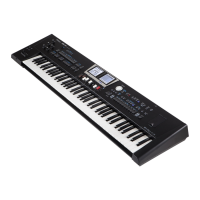Rhythm Composer
116
your settings and edit the data.
The display briey conrms the operation and then returns to the
current Composer page.
Time Signature
The “Time Signature” parameter allows you to check and set the
time signature of the patterns. The major, minor and seventh Modes
of a pattern must always use the same time signature, which is why
you cannot edit them separately.
Use this parameter to specify the time signature of the selected
pattern (“Division”, see below). The MAIN, INTRO and ENDING
instances comprise four variations, which is why there are four
“Time Signatures” values you can select using the VARIATION [1]~[4]
button icons. When you select “Fill Up” or “Fill Dwn” for “Division”,
only three “Time Signature” instances can be edited.
The most commonly used time signatures are: 2/4, 3/4, 4/4, 6/8 and
12/8. Other values (such as 7/4, 13/8, etc.) are also possible.
NOTE
When you change the time signature of an already recorded
pattern, its notes and events are “reshued”, so that you may
end up with incomplete measures. None of your data are
deleted, however.
Right Display
1. Use the dial to edit the following parameters.
Parameter Setting Explanation
Division
Intro, Main, FillDwn,
FillUp, End, ALL
Use this parameter to select the
Division you want to edit.
Time
Signature
1~32/16, 1~32/8,
1~32/4, 1~32/2
This parameter allows you to set the
time signature.
Var1
On, O
Use these parameters to select the
pattern you want to change. If you set
“Division” to “Fill Dwn” or “Fill Up”, there
are only three button icons. You can
switch on several or all button icons if
you like. (But you cannot switch o all
four or three.)
Var2
Var3
Var4
2. Press the [WRITE] button (its indicator ashes) to conrm
your settings and edit the data.
The display briey conrms the operation and then returns to the
current Composer page.
Editing Individual Rhythm Events
(Micro Edit)
Select this mode if you need to change just one aspect of an
otherwise perfect rhythm.
In this section, we will use the word “event” for any kind of message.
An event is thus a command (or instruction) for the Arranger.
You can only view and edit one track at a time. Therefore, be sure
to check the “Track” setting before editing the events displayed on
this page.
1. Press the [QUICK MENU] button (its indicator ashes).
The display changes to:
Left Display
2. Rotate the dial to select “Micro Edit”, then push the dial.
The displays changes to:
Left Display
Right Display
3. Select the left “Micro Edit“ page.
4. Use the “Track”, “Mode” and “Division” parameters to
select the pattern you want to edit.
The Right display will show the list of events of the selected track.
Right Display
Each event is executed at a
given point in time, which is
why they all have a position
indication.
Single Event
Value
To change information already available on the selected track,
proceed as follows:
5. Rotate the dial to select the list entry you want to edit.
When you move the cursor to a note event, it is played back. This
may help you identify the occurrence you want to edit.
6. Push the dial to select the rst value.
In the following examples, we selected the CC00 message (left) and
the rst parameter of a note event (right):

